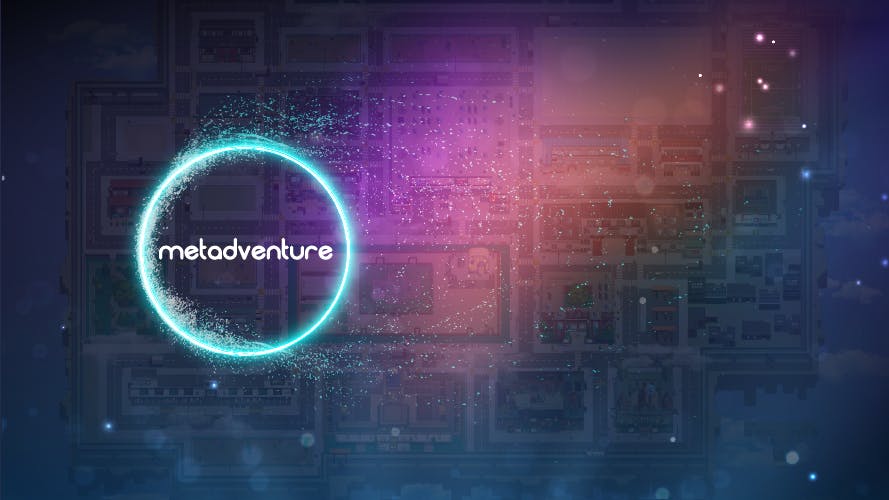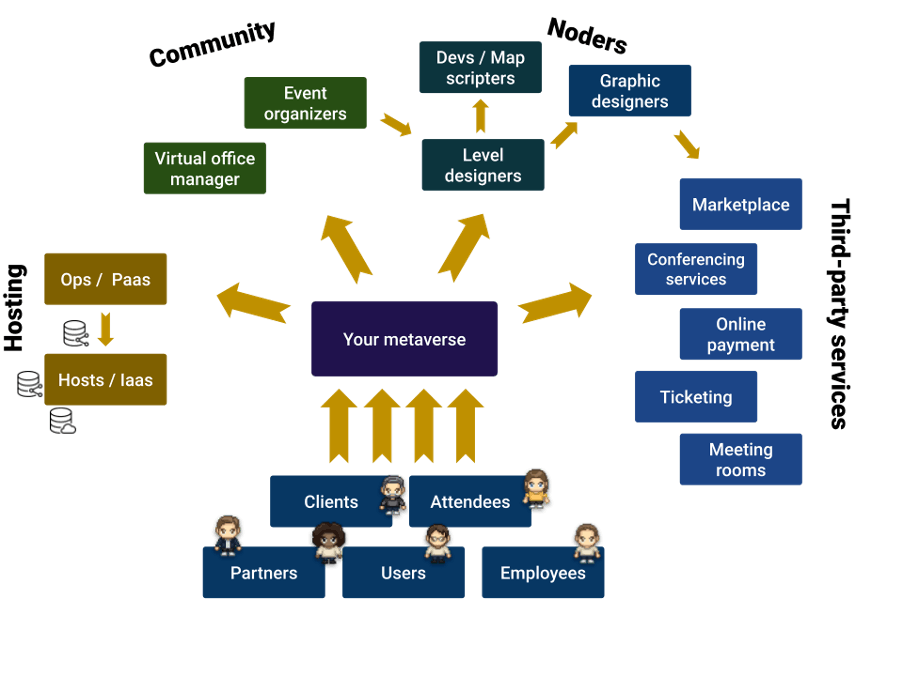🪐 Metadventure: WorkAdventure’s metaverse builder

Summary
2. WorkAdventure starts drawing attention from the Web3 community
3. Diving deep in the Web3 ecosystem
6. Metadventure: what does it imply to create a metaverse builder?
The WorkAdventure team is working on building an open and decentralized metaverse by proposing a "metaverse builder". This metaverse builder will be released under a new name: Metadventure. The WorkAdventure engine will power this builder, which will be tightly connected with the Web3 ecosystem. The business model will be drastically different from what we have now. If you are a WorkAdventure user, WorkAdventure will not be impacted by those changes. The WorkAdventure engine (that you install in the "self-hosted version") will remain "Web3 agnostic" and the SaaS version at https://workadventu.re will keep living as it is.
If you want to understand the rationale behind this move, read this.
Why a metaverse builder?
To understand why we will build a metaverse builder (Metadventure), it is interesting to dive into the current WorkAdventure business model, its advantages and its shortcomings.
We started working on WorkAdventure 2 years ago, in the midst of the pandemic. Our mission has always been to bring back a bit of humanity and spontaneity when working or attending an event remotely.
Two years ago, a solution like WorkAdventure was truly innovative. However, many other developers encountered the same issues we did and came up with comparable solutions. Virtual universes (or metaverses) started pouring. Today, WorkAdventure has a number of competitors like Gather, Cosmos, Topia or Teamflow. Most of our competitors raised hundreds of millions of dollars from venture capitalists.
In this regard, WorkAdventure is an exception.
First and foremost, we are the only open solution out there. You can install a WorkAdventure server, tweak it, contribute to the evolution of the ecosystem, and so on. We received several contributions because our code is public on GitHub: companions, animated maps, the desktop application, countless bug fixes...
We are glad to have made this choice! Being open & transparent has also allowed us to be selected by the Chaos Computer Club in the organization of its Remote conference in 2020 & 2021. It provided us incredible visibility all around the world and allowed them to create a 'Multiverse' for their event: 1.500 worlds interconnected & 30.000 attendees.
But even with the power of the open-source community (and even by being more open to donations) we are far from matching the man-power that can bring you dozens of millions of $!
Today, we are a 100% self-funded 10 people company. We must level up and equal this level of funding if we are to remain competitive. If you think we can do otherwise, I invite you to read this excellent thread from Andrew Wilkinson. As genius as we may be, we cannot compete with such a gap in funding.
Now, accepting VCs money to build is the “classic route”. We will start by spending thousands of $ in ads, improving our monthly revenues, reducing our churn, converting more freemium users etc…
This means building a set of "premium" features and keeping it away from the self-hosted version.
Some businesses are really successful with this model. For instance, GitLab does a great job at providing a great open-source project while having a paid-for "enterprise" edition.
WorkAdventure is already going down this road.
Our licence is protecting our premium version. It is based on the APGL v3 licence with a specificity: it forbids selling access to WorkAdventure online. So to say, you can install WorkAdventure within your company, at a university or for yourself. But you cannot resell subscriptions or any kind of services.
Furthermore, today, the administration dashboard is not part of the self-hosted version. It means that applying a set of rights to some users is almost impossible unless you are using our premium version.
As a result, our community is already working on alternative administration dashboards for WorkAdventure. Furthermore, we did not take time to properly document the API to build the admin dashboard. So our community is struggling to build one and I understand this can be quite frustrating for them.
This situation is frustrating for both parties. We are both working on similar features = waste of effort & time.
From the community standpoint, they are targeting an API that keeps changing. This is hard for them.
From the WorkAdventure standpoint, having admin dashboards available in open-source means having more competitors and less incentives for our consumers to pay for the SaaS version. Thus less income to keep improving WorkAdventure.
But the frustration does not end here!
WorkAdventure has a perfect architecture to be federated. Ideally, it should be easy to jump from one server to another simply by taking an exit in a map.
In practice, the federated version of WorkAdventure is not a priority for the company, as it goes against its direct interests (i.e. retaining a maximum of users in the premium version). In more than 2 years, we never took the time to work seriously on this most needed feature!
So here we are. The SaaS business model. Even if it is a robust and proven business model, has its flaws.
Could there be a better alternative? A solution where we would not be in competition with our community and ourselves? A solution where we could encourage everyone to host and offer subscriptions to WorkAdventure? I have been desperately looking for one, until...
WorkAdventure starts drawing attention from the Web3 community
In the past 8 months, more and more projects from the web3 world came to see us.
Web3 projects are all about building communities. And of course, WorkAdventure is a super (if not perfect) tool to build communities, to meet, interact and work together. Most of these projects want a virtual universe (or a metaverse), for various purposes: a meeting place for a DAO, a metaverse for your NFT project, a virtual shop etc... and WorkAdventure is the perfect match for them.
Diving deep in the Web3 ecosystem
The first contact I had with "real people" doing Web3 things was very different from the initial perception I had from this ecosystem.
I need to say that my initial perception of the Web3 ecosystem was fairly negative. "It is catastrophic for the environment!", "It is just a giant ponzi-scheme!". All those negative comments I heard and read online, I kept in my head but decided to take a deep-dive and see for myself.
And for the most part... let's be realistic. Those comments are completely true!
Web3: the dark side
I saw so many NFTs projects that make utterly no sense and propose nothing. I have seen people rushing to mint a NFT for about $1000 (!), only to see their transactions failing and paying about $90 gas fees... which means burning $90 of energy for… literally nothing!
I also saw scams. An incredible number of scams. The Web3 ecosystem is definitely a wild wild place and the acronym DYOR really means it.
Web3: the bright side
But I also met a number of great people. Some are working on layer 2 networks that are faster and more energy efficient by an order of magnitude. When doing tests, we managed to "mint" a complete collection of NFTs for less than 30 cents in gas fees. Since the energy price is capped by the gas fee, this is definitely going in the good direction. Surprisingly, the energy efficiency of the ecosystem is already a solved problem... provided you choose the right technology!
Technically, some of the building blocks of a Web3 application are amazing. Building a distributed authentication mechanism using Decentralized Identifiers is an already solved issue (one of the things we need to build a federated version of WorkAdventure by the way!).
But this is not the best thing I saw. The really inspiring part came from the analysis of some of the top projects. They are trying to think and design a whole ecosystem around the project.
Projects like The Sandbox or Filecoin are planning inside their own ecosystem a way for each role in the community to benefit from their project. This is exactly what I would dream to achieve with Metadventure, our metaverse builder.
Metadventure: what does it imply to create a metaverse builder?
I have been working on WorkAdventure for 2 years, but I also have been using it for 2 years. For 2 years, my avatar has been seated in an open virtual office welcoming everybody. No other tool would have let me do it. Call me crazy but I strongly believe we are at the forefront of a new revolution. 30 years ago, few businesses understood the need for a website. Today, when you are launching a new business, you start with the website. The funny thing is that having a website is called nowaday "having an online presence". But no real person is really online, right? I very much believe that in a few years, starting with a real online presence, with real people in a virtual universe (or metaverse) will be a must.
30 years ago, building a website involved finding a developer that mastered the art of HTML and FTP. And that was about it. Today, this involves a number of different parties: designers, writers, developers, hosts, ops, SEO specialists, marketers, SEM professionals, community managers...
The metaverse ecosystem is meant to evolve in the same direction. Let's have a quick look at what services you may need to create a virtual ecosystem in a metaverse builder like Metadventure:
- You need graphic designers, to give your universe a unique touch
- You need level designers, to organize the space into zones that make sense (not too big, not too small...)
- You might need a virtual office manager (or an online happiness officer) to organize your online space when needed
- You need event organizers for your big events
- You need developers / scripters to implement dynamic behaviours in your worlds
- You also need ops to install and take care of the servers
- Or you will need a host that will provide you with a hosted service and provides the necessary bandwidth for relaying the video signal
- You will most possibly install plugins provided by third parties. For instance, a plugin/service to organize big meetings or gather analytics
- Finally, you will need to rely on the work of the developers of the metaverse builder you choose (in our case: Metadventure)
- ... and that's only today! In the future, a number of new roles will probably appear.
All those roles will need to share incentives and organizing those economic streams through a token makes a lot of sense.

Taking a look at The Sandbox, a fee is applied to each transaction. 50% of this fee is invested in maintaining the ecosystem and creating additional game content for The Sandbox.
Now, let's imagine we build something similar with Metadventure. By taking a small fee on all transactions (maybe less than 1%), the metaverse builder could have a sustainable stream of revenues (assuming a very large number of users of course).
The really nice thing about this approach? It does not suffer from the downfalls of the SaaS business model. As a platform developer, if I know that my revenue stream is based on how much people are using my platform, I have interests that are aligned with the interests of the wider community. The more the community is successful and the more it earns with Metadventure, the more Metadventure directly gains from it.
This is a complete paradigm shift. It could mean that:
- We could allow (and encourage) other companies to host our metaverse builder. To be honest, from what I have seen in the WorkAdventure community, I know many of you have the skills to do it extremely well!
- We would not need to put any "premium features" and could release everything as openly as possible.
In the future, we could also let contributors to the core platform contribute and benefit from the revenue stream from the fees using a DAO (Decentralized Autonomous Organization).
Metadventure, WorkAdventure’s metaverse builder, is only on the paper so far. We are deeply focused on making it real. We still have a lot of things to sort out. But I hope that by reading this article, you understand better why we are looking into this direction. If you are skeptical about anything Web3 related, I hope that this article will help you figure out the rationale.
